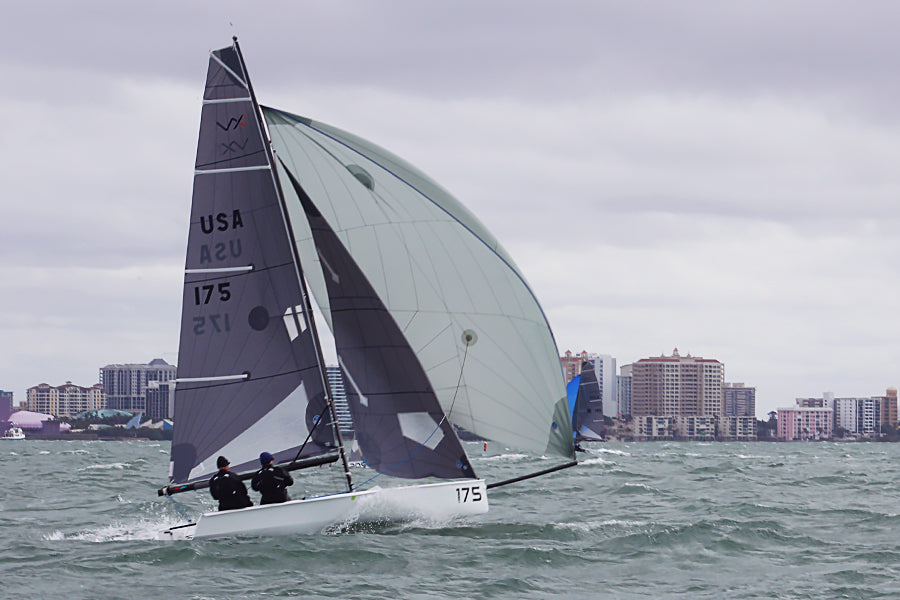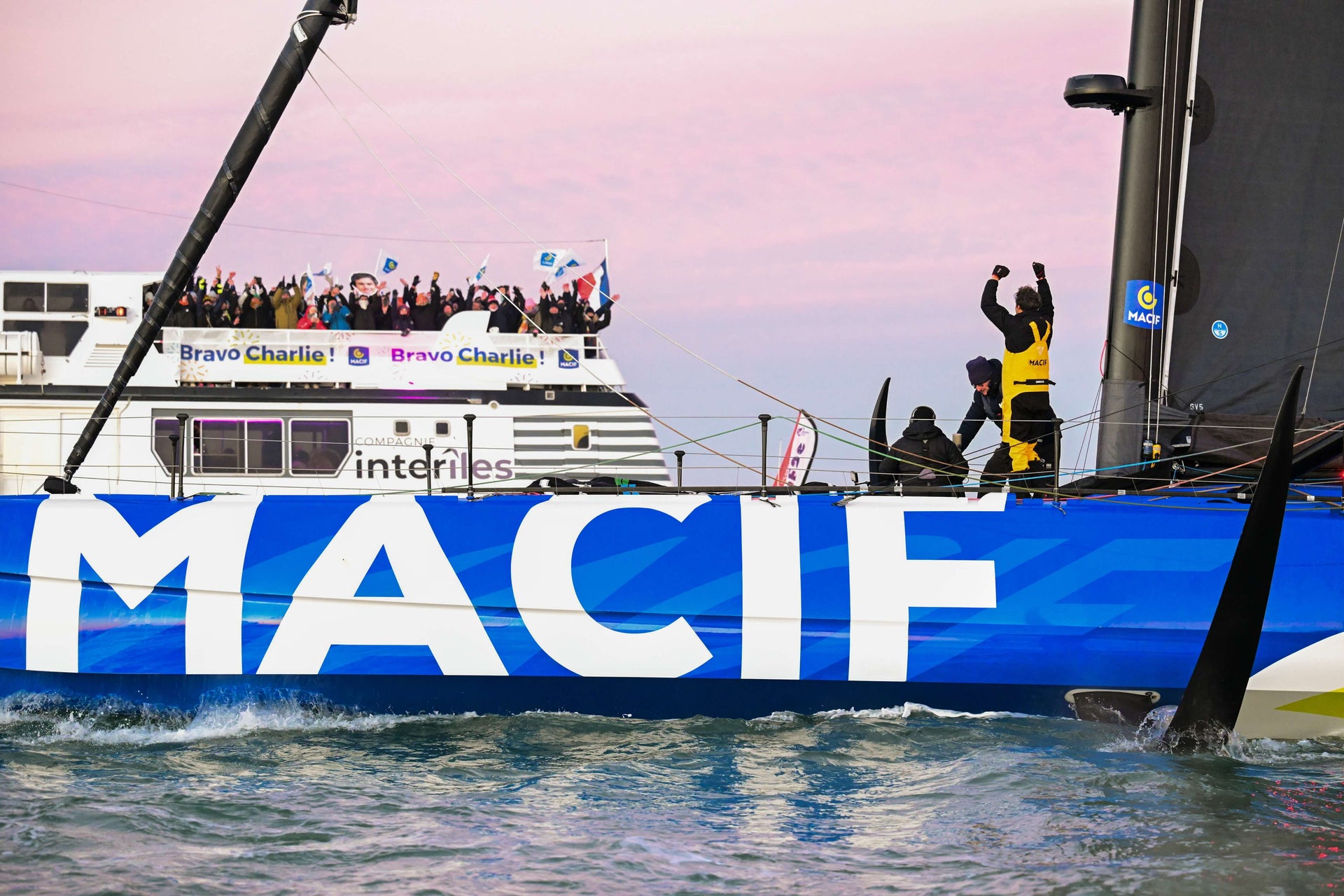VX ONE MIDWINTERS CHAMPIONSHIP
VX ONE MIDWINTERS CHAMPIONSHIP
North Sails powers clients to the top in big breeze on Sarasota Bay

The VX One Midwinters, hosted by Sarasota Sailing Squadron, was a wet and wild one with strong breezes ranging between 15-18 knots giving sailors a thrill all weekend long. Sailors felt the need for speed in this fun and exciting one design class, hiking hard in the fight to be number one at the end of the day. North-powered clients deemed to be fastest, placing 1, 2, 3, 4, 5, 6*, 7, and 9th out of 23 teams. North Sails VX One expert, Jackson Benvenutti joined Richard Heausler’s team Second Line placing second overall, just two points away from first place finishers Jeff Eiber, on Calvin Ball. Jeff stated: “Going into this regatta I felt very fortunate to have my son sailing with me. So my primary goal was to keep the communication and psychology 100% positive and focus on enjoying our time together both in the boat and onshore. As the regatta progressed we noticed that the more time we spent thinking, looking around, and talking, the better we sailed or at least the easier it seemed to go the right way.
“We were very quick off the wind and having a blast too! Not capsizing in the jibes let us pass lots of boats downwind so we survived the windy day with 11 points. The next two days were in moderate wind so even though we were a little slower upwind with old sails and less weight we were still one of the fastest boats downwind. I was also happy with the performance of our 2 year old, very high mileage North sails. The VX is a very crew weight-wind speed sensitive boat. Of course it feels good to win but I feel an even bigger sense of satisfaction from sailing with my son and enjoying the warm camaraderie of my fellow VX sailors”, said Jeff.

To top off the podium in third place was Sam Padnos on TWD, also very close behind keeping the racing very close and exciting. Saturday was above all the windiest days and many teams experienced a little capsizing exercise during racing. Jackson’s team ended up in the drink a few times, but was still able to hang on to their positioning. Jackson stated,
“Flipping over three times in two races was certainly humbling and a bit of a reality check on our (lack of) weight in the big breeze. But we were in the mindset to live to fight another day and take advantage of the slightly lighter forecast for the next two days of the regatta. That common saying ‘you can’t win a regatta on the first day, but you can certainly lose it’ came to mind. We knew we had a bit of a hole to dig out of, but felt like we still had a chance to do well.”
After the weekend, Jackson reflected on some key points that contributed to his teams’ success over the weekend. Along with not giving up, here’s what he had to say about rig tuning, body placement, sail trim, and the true power of hiking hard.

Jackson’s 10 Takeaways:
1) Make sure the main halyard is all the way up! The mast bends a lot, which makes the mainsail fall down a little bit. Rig a halyard that is a bit thicker than the standard diameter spectra halyard where it goes around the cleat. To achieve this, we inserted a core inside the main halyard about 2 feet long where the halyard fit around the cleat when the mainsail was fully hoisted. This will also help with the line slipping over the cleat and gave us a bit of a better grip to pull it up those last few centimeters. In the breezier conditions, about 80% of the fleet had their halyards slipping below max hoist.
2) Batten tension is crucial and should be monitored to assure that you never have any vertical wrinkles along the batten pockets, especially the full-length battens! Using stiffer battens for the top battens in the main and jib will also help flatten out the top of both sails in the big breeze!
3) Cap shroud tension is important. We actually bottomed out our cap shrouds after 19.5 turns from the base setting, and would have liked to put about another 6 turns on if we could have! Ideally, the shrouds would be a little bit shorter, trimming a 1/2 inch off both studs will help achieve more cap shroud tension. However, you have to turn the lowers as well if you are cranking on the caps. If you don’t, you’ll end up with too much mast bend and over-bend wrinkles in your main, especially when you apply proper vang tension. Not having proper lower and checkstay tension will allow the mast to bend too much, and will actually decrease the headstay tension you are trying to achieve (indicated when the mainsail begins to show overbend wrinkles which extend from the middle of the luff near the spreaders and run towards the clew). Generally, the best ratio of cap shrouds to lower shrouds seemed to be 3:1. That means 1 turn on the lowers for every 3 turns on the caps.
4) In chop the boat sailed well flat with the bow down and the sheets eased, in particular, the mainsheet.
5) When executing the planing/bow down mode upwind with the mainsheet eased to keep the boat flat, the jib cannot be trimmed too hard or else the slot will be closed off. The best way to keep the top of the jib open was to move the sheet down on the clewboard of the jib. Our sheet lived in the bottom 3 holes of the clewboard and felt especially fast one hole up from the bottom in the 15-18 knot breeze. This allowed us to flatten the bottom of the jib, keep the top twisted open, and inhaul the jib properly to the sweet spot (around 6 degrees of sheeting angle).
6) Trimming and easing both sails together upwind proved to be very fast! Easing the jib and main together as a puff hits allowed the boat to transfer the extra wind velocity into forward boat speed without the boat heeling over too much. Plus, this keeps the keel deeper in the water. We found that allowing the boat to go fast forward through the water (instead of trying to ride a puff up with the sheets in and feathering) would make the keel become more efficient, which in turn provided height. In short, your pointing would come from speed.
7) Downwind the boat was very sensitive to weight movement. Being aggressive with your fore and aft movements really worked well. Move forward to initiate planing, slide aft while planing, and then move forward again to prolong planing. In marginal planing conditions, if the skipper has to turn up to keep planing, you should be moving forward. If he has to turn down to keep the boat at the proper angle of heel, you should be moving aft. Sometimes it was possible to get the bow up and over a wave that you might not have been able to get over with a short-lived slide forward.

8) Keep the gears changing! On the last day of the midwinters, the breeze was pretty puffy. This caused the boat to go from underpowered to overpowered very quickly, and vice versa. The key in those conditions is to constantly be looking at the wind that will be immediately affecting your sails and be proactive about the changes in velocity (not reactive)! The jib halyard tension and main cunningham are very easy to adjust and should be adjusted constantly in those conditions. Our boat is rigged up so that the jib halyard and main cunningham are actually the same continuous line. This makes it easy to keep track of where that line is, if I grab one, I have both of them. The adjustments on the luff on both of the sails would range from wrinkles in 50% to completely smooth, which will properly change the shape of your sails for the given wind condition. Basically, the boat will either be overpowered or underpowered, so you want a looser luff when you’re underpowered and a firmer, smooth luff when you’re overpowered.
9) Jib trim downwind is key. I think most people overlook it and focus more on the bigger sails, the kite, and mainsail. However, if the jib is under trimmed, then you are losing power and speed that you could easily have and you’re also dragging the sail through the air which is actually slowing you down! If the jib is over trimmed (which is worse than under trimmed) it completely closes off the slot which then essentially acts as a handbrake to your boat. An over-trimmed jib downwind will kill both the flow over the kite and the flow over the main. Not good! The best jib trim is with the car all the way down on the track, and then trim the sheet so that the top 1/5th of the jib is spilling open and slightly luffing. This trim technique will ensure a few things: the jib is trimmed in a way that keeps the groove wide open downwind so the driver can actively steer to the pressure changes, it will provide extra power in the sail plan to help sail slightly lower, and will keep the breeze flowing through the slots! The jib will need small adjustments every now and then as the boat goes through puffs and lulls. The main point is, don’t ignore the jib downwind!

10) There is no good substitute for hiking hard and good physical fitness. It’s simple, the harder you hike, the flatter you keep the boat, the less you slide sideways and the better the keel works! Hiking hard also means you can sail the boat with a little less weight, which can pay huge dividends on the downwind legs. Being physically unfit not only means you can’t sail the boat to its full potential, but it creates a snowball effect due to fatigue where you can’t make the boat go fast enough, your mind can’t process information as fast, and you make bad decisions. Body-weight workouts are worth their weight in gold in a class like the VX One. Staying well fed and properly hydrated also helps a ton in fighting fatigue. The VX One is a physically demanding boat!
Interested in our products? Contact your local VX expert today!
| VX One Midwinter Championship | ||
| 1 | Calvin Ball / Jeff Eiber | |
| 2 | Second Line / Richard Heausler | |
| 3 | TWD / Sam Padnos | |
| 4 | VX One / John Potter | |
| 5 | Chuck Wagon / Phip Hallowell | |
| 6* | Isabelita Con Queso / Christopher Alexander | |
| 7 | Character 3.0 / Justin Quigg | |
| 8 | Wild Deuces / Paul Currie | |
| 9 | GiddyUP / Kevin Gillman | |
| * Denotes Partial North Sails Inventory | ||





